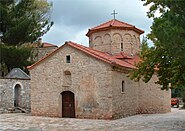In Orthodox Christianity and certain other Eastern Christian communities, Lavra or Laura (Greek: Λαύρα; Cyrillic: Ла́вра) is type of monastery consisting of a cluster of cells or caves for hermits, with a church and sometimes a refectory at the center; the term in Greek initially meant a narrow lane or an alley in a city.[1][2]
History[]
The Lavrite style of living has its origins in the early fourth century with the founding of a settlement of cells in the Nitrean desert at a site known as Nitria, named for the nearby town of the same name. It was a community of 600 hermits lived scattered over the area, reliant on the town of Nitria for bread, but with their own priest and church. Saint Euthymius the Great (377 - 473) founded one of the early Lavras in fifth-century Palestine.[3] The Lavra of Saint Sabbas the Sanctified (†532), known as Mar Saba, is one of the most ancient continuously functioning monasteries in the Christian world.
A similar system was established by Saint Gerasimus, with 70 cells surrounding a cenobium, again with monks progressing into the cells after time spent in the coenobium. Weekdays were spent in the cells, accompanied only by a rush mat, a small amount of food and palm blades with which to make ropes and baskets. On Saturdays they would bring their handiwork to the coenobium and receive communion together, returning to their cells on Sunday evening. Cells were left open, and those in need could take whatever they wished from the cell if it were found empty. The lavra had a priest; the lavra’s contact with the outside world, and at least two ordained deacons.
The largest and the most important Russian Orthodox monasteries have been called lavras and have been subordinated directly to the Patriarch of Moscow. In 1721, they became subordinated to the Holy Synod. The Great Lavra founded by Athanasius the Athonite in 963 is the oldest monastery on Mount Athos.
List of lavras[]
- Georgian Orthodox Church:
- David Gareja Lavra (since 1505)
- Greek Orthodox Church:
- Lavra of St. Sabbas (Mar Saba) (532)
- Megisti Lavra, Mount Athos (10th century): the Great Lavra
- Agia Lavra
- Polish Orthodox Church:
- Supraśl Lavra (since 1505)
- Russian Orthodox Church:
- Troitse-Sergiyeva Lavra (since 1744) Trinity-St. Sergius Lavra
- Alexander Nevsky Lavra (since 1797) St. Alexander Nevsky Lavra
- Ukrainian Greek Catholic Church:
- Univ Lavra (since 1898) Univ Holy Dormition Lavra of the Studite Rite
- Ukrainian Orthodox Church:
- Kyiv Pechersk Lavra (since 1051) Kyiv Caves Lavra
- Pochayiv Lavra (since 1833) Pochayiv-Dormition Lavra
- Sviatohirsk Lavra (since 2004) Holy Mountains Lavra
See also[]
- Coenobium (Monastery)
- Hermitage
- Skete
References[]
- ^ λαύρα. Liddell, Henry George; Scott, Robert; A Greek–English Lexicon at the Perseus Project.
- ^ Kazhdan, Alexander P., ed (1991). "Lavra". The Oxford Dictionary of Byzantium. New York, Oxford: Oxford University Press.
- ^ Parry (1999), p. 294
Sources[]
- Parry, Ken; David Melling (editors) (1999). The Blackwell Dictionary of Eastern Christianity. Malden, MA.: Blackwell Publishing. ISBN 0-631-23203-6.
External links[]
- (English) The Holy Trinity-St. Sergius Lavra
- Photo of "Holy Mountain" (Sviatogorskaya) Lavra in Ukraine
 "Laura". Catholic Encyclopedia. New York: Robert Appleton Company. 1913.
"Laura". Catholic Encyclopedia. New York: Robert Appleton Company. 1913.







